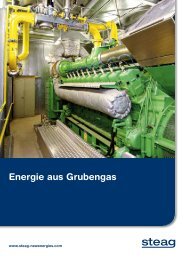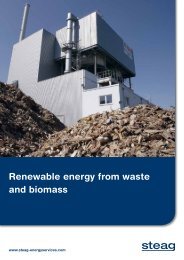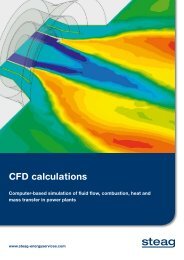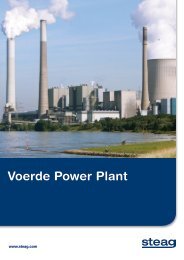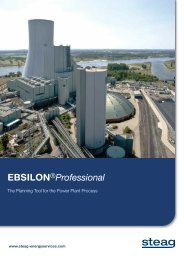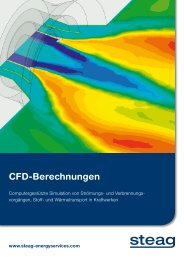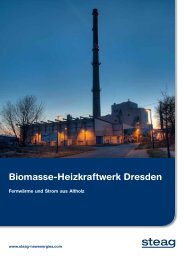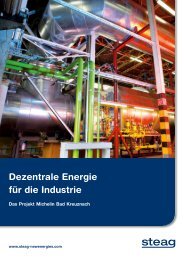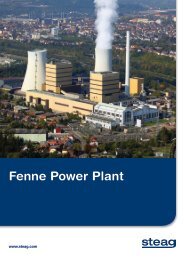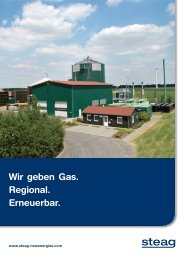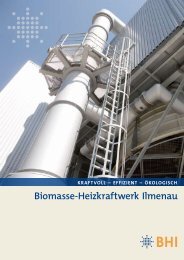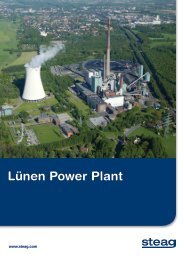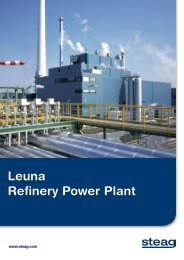Weiher Power Plant - STEAG
Weiher Power Plant - STEAG
Weiher Power Plant - STEAG
- No tags were found...
Create successful ePaper yourself
Turn your PDF publications into a flip-book with our unique Google optimized e-Paper software.
<strong>Weiher</strong> <strong>Power</strong> <strong>Plant</strong>www.steag.com
<strong>Power</strong> and heat for the futureEnergy, for more than 90 yearsAs fifth biggest electricity producer in Germany, with ultramodernpower plants in and outside Germany and a variety ofservices, <strong>STEAG</strong> GmbH safeguards the energy supply of thefuture – reliably, efficiently, and with low environmental impact.<strong>STEAG</strong> blazes the trail for the energy sources biomass,biogas, mine gas, geothermics, wind and solar thermics. Theengineers of <strong>STEAG</strong> Energy Services GmbH develop, buildand operate power plants all over the world and are expertsfor the modernization of existing plants and for made-tomeasureenergy supply which goes easy on the climate andat the same time is economical.<strong>Power</strong> plants at home and abroad<strong>STEAG</strong> operates eleven power plants at ten locations inGermany with an installed capacity of about 7,500 MW; nineof these plants use hard coal as primary energy source. Attwo sites, each of which integrates an industrial power plant,refinery by-products also are used to produce steam, compressedair and electricity. Most of the electricity from hardcoal is supplied to industrial and public utilities. The customersinclude RWE, EnBW and Deutsche Bahn, the GermanRailways. Where there is a demand for it, cogeneration –the simultaneous production of power and useful heat – ispracticed. This heat either is used for heating purposes oris purchased by industrial enterprises in the form of processheat for their production processes. Outside Germany, too,the company contributes to public power supply with threehard-coal-fired power plants, capacity about 1,700 MW, inTurkey, Colombia and the Philippines. The efficient powerplants of <strong>STEAG</strong> make an active contribution to a secure andsustainable supply of energy.With a total installed capacity of 724 megawatts, the<strong>Weiher</strong> III power plant in the town of Quierschied in theSaarland produces, besides electricity, district heating forthe nearby community. In all, around 1.7 billion kilowatthours(kWh) of electricity and around 13 million kWh thofdistrict heating are generated each year at the plant. Theelectricity could supply the needs of about 425,000 singlefamilyhouseholds.The boiler in <strong>Weiher</strong> is a so-called outdoor boiler and thereforean unusual piece of architecture. In pure visual terms theoutdoor boiler clearly sets the power plant apart from otherplants, because it lacks an enveloping boilerhouse façadefrom about halfway up the boiler. Coal is delivered to thepower plant by rail. The coal storage yard has a capacity ofabout 150,000 tons of coals. A fully automatic belt conveyorsystem transports the coal via holding bunkers in the boilerhouseto the six coal mills; it is then air-blast fed into thefurnace in finely pulverized form.In an internal combustion engine which also belongs to thepower plant, mine gas is burned and transformed into electricalenergy and heat.Saar River water for power generationThe make-up water for the cooling tower, through whichsome 60,000 cubic meters (m 3 ) of cooling water flow eachhour, is pumped into the power plant through a 16-kilometerpipeline from the Saar River. The make-up water volume comesto about 1,000 m 3 per hour. Before the river water canbe used, it is purified in a water treatment plant.
The power plant processThe coal, as much as 6,000 tons per day, is shipped to <strong>Weiher</strong>by rail. From there it is transported to the coal mills. Themills pulverize the fuel, which is dried with hot air and thenburned in the furnace at temperatures of about 1,200 °C.During combustion, hot flue gas is formed. In kilometers oftubes in the steam generator, the flue gas heats water tomake steam. The steam, which reaches a temperature ofup to 530 °C and is under high pressure, is conducted intoa turbine where it impacts the turbine blades and causesthe turbine shaft to rotate. A connected generator produceselectricity from this motion, like a dynamo. Transformersbring the electricity up to the necessary voltage and feed itinto the grid.When the steam has finished its work in the turbine it isconducted into a condenser. This is a large heat exchangerwith many tubes in which cooling water circulates. Thesteam comes in contact with the tubes and forms droplets(condensation), much like humid air on a cold window pane.The condensed water droplets are collected and pumpedback into the boiler to complete the cycle. In the process thecooling water from the condenser heats up from about 20 °Cto 30 °C. It is piped into cooling towers where it cascadesdown and cools off again. A small portion evaporates and isreplaced by water from the Saar River.Combined heat and power from QuierschiedIn addition to electricity, heat is produced in <strong>Weiher</strong>. At severalpoints in the turbines, steam is extracted to heat water underpressure to a temperature as high as 180 °C for district heatingpurposes. This water then is fed into the district heatingsupply system of the town of Quierschied.Protecting the environmentSchematic illustration of the power plant processFrom the viewpoint of physics, energy is not produced, but merely transformed. The energy is fixed to the coal in chemical form. The coal is burned in theboiler; the released heat heats up water. This gives rise to hot steam (thermal energy) which drives a turbine (mechanical energy). A connected generatorthen transforms this mechanical energy into electricity (electrical energy).When coal is fired, flue gases form which contain mainlyparticles of ash, dust, nitrogen oxides and sulfur dioxide. Formany years <strong>STEAG</strong> has been using highly effective methodsto reduce the emissions of these substances. When a powerplant is built today, a third of the expenditure goes intoenvironmental protection, most of it into air pollution control.<strong>STEAG</strong> will make substantial investments in environmentalprotection in future too. The emissions of the power plantare continuously measured. The company’s environmentalprotection officers monitor and evaluate the measurements.In addition they have independent bodies like the Germaninspecting authority TÜV make measurements.Noise control for the environmentWhen planning the <strong>Weiher</strong> power plant, <strong>STEAG</strong> <strong>Power</strong> Saarmade practical use of natural conditions to keep plant noisesfrom reaching the neighboring community of Quierschied.The entire plant was nestled into the valley in such a way thatit is surrounded by a natural protective wall.Cooling tower with flue gas dischargeIn <strong>Weiher</strong>, since 1988 flue gas which has been cleaned byDeNO xreactor, electrostatic precipitator and flue gas desulfurizationplant is discharged into the cooling tower, where itrises up into the atmosphere together with the water vaporfrom the cooling tower. This saves energy, as the flue gasdoes not have to be reheated so that it can be dischargedthrough the stack.Clean waterThe wastewater discharged by the power plant into the nearbyKohlbach brook is cleaner than the water extracted fromthe Saar River to operate the plant. Before it leaves the plant,all wastewater is subjected to intensive mechanical, chemicaland biological treatment if required.Valuable by-productsThe <strong>STEAG</strong> subsidiary <strong>STEAG</strong> <strong>Power</strong> Minerals GmbH isresponsible for recycling the by-products of all <strong>STEAG</strong> hardcoal-firedpower plants in Germany. <strong>Power</strong> plant by-productswhich originate in the firing process are valuable and aremarketed. The by-products include fly ash, boiler sand, slagtap granulate and FGD gypsum.These power plant by-products are environmentally soundand can be used in almost all applications as constructionmaterials without impairing the soil or groundwater. Treatmentis only necessary in special cases. In contrast to thenatural resources which are becoming increasingly scarce,power plant by-products will be available in the longer term,conserving natural raw materials.
Data and facts *Installed capacityInstalled capacity 724 MWDistrict heating capacity max. 30 MW thSteam generator Forced-circulation boiler simple reheatSingle-pass boilerdry ash removalSteam flow at full load 2,100 t/h sliding-pressure operationSteam pressure186 barSteam temperature 525 °CAnnual coal consumptionUseful electricity outputDistrict heating (heating supplied)Turbine unitGeneratorMain transformerCooling towerWater vapor escaping from coolingtowerDust removalFlue gas desulfurization (FGD)about 630,000 t / 590,000 tceabout 1.7 billion kWh / aabout 13 million kWh th/ aFour-cylinder condensing turbineHP inlet: 177 bar / 525 °CIP inlet: 36 bar / 530 °CLP inlet: 6 bar / 280 °CRated output: 800 MVAGenerator rated voltage: 21 kV2 50 %-duty transformersRated output: 385 MVA eachRated voltage: 21 kV / 245 kVNatural-draftHeight:135 mDiameter at base: 100 mWater flow: 60,000 m 3 / h1,500 m 3 / h2 electrostatic precipitatorsLime slurry scrubbing with ground limestone, gypsum as final productA site with a traditionNO xremoval (DeNO x)SCR system (Selective Catalytic Reduction)By-productsFly ash, boiler sand, gypsumInitial start-up 1976Operator<strong>STEAG</strong> <strong>Power</strong> Saar GmbHThe <strong>Weiher</strong> power plant has a long tradition. It stands on theoldest power station site in the Saarland. In January 1918the first plant at the <strong>Weiher</strong> site was put into operation indirect proximity to the Göttelborn coal mine. The <strong>Weiher</strong> Ipower plant followed in 1943 / 1944.In the 1960s the <strong>Weiher</strong> II power plant (put into service in1963 / 1964) was regarded as a pioneering achievement inthe field of environmental protection. The <strong>Weiher</strong> III pow-er plant (put into operation in 1976) continued to play thistrailblazing role, boasting peak results for dust removal, andespecially for desulfurization and NO xcontrol. Moreover, in1976 <strong>Weiher</strong> III was the first hard-coal-fired power plant inthis capacity class in Europe. Whereas the older plants meanwhilehave been taken out of service and dismantled, theunit <strong>Weiher</strong> III continues to generate power in environmentfriendlyand reliable operation.Owner<strong>STEAG</strong> <strong>Power</strong> Saar GmbH<strong>STEAG</strong> refers to the gross maximum capacity under nominalconditions as installed capacity. This is the continuousoutput that can be attained under normal conditions. It islimited by the weakest part of the plant (bottleneck), is determinedby measurement and converted to normal conditions;stated in MW, calculated as MW electric and equivalent(thermal output).The standard coal equivalent or ton of coal equivalent(tce) is a commonly used unit of measure in Central Europe,though not a statutory unit of measure, to compare the energycontent of primary energy sources. 1 ton coal equivalent =29.3076 gigajoules (GJ) = 8.141 thermal megawatt-hours(MWh th).* as at December 31, 2011
<strong>STEAG</strong> GmbHRüttenscheider Strasse 1–345128 EssenGermanyPhone +49 201 801-00Fax +49 201 801-6388Email info@steag.comwww.steag.com<strong>STEAG</strong> <strong>Power</strong> Saar GmbHTrierer Strasse 466111 SaarbrückenGermanyPhone +49 681 9494-05Fax +49 681 9494-2244Email info-powersaar@steag.comwww.steag-powersaar.com<strong>Weiher</strong> <strong>Power</strong> <strong>Plant</strong>Holzer Strasse66287 QuierschiedGermanyPhone +49 681 9494-7206Fax +49 681 9494-7295Email sekretariat-weiher@steag.comV-UK, as at June 2012



